To see a swatch of the German countryside all at once the aptly named Romantic Road Germany in the southern part of the country is a top choice.
Traveling along what was once a major trade route in the Middle Ages you will find the journey full of old-world charm and untouched landscapes. At 261 miles long the Romantic Road Germany covers a lot of ground leaving you with many options for how to spend your time.
No matter where you decide to stop along the way picturesque towns, historic castles, vineyards, mountains, and more will greet you along the way.
You can pick and choose how much time you’d like to spend and where you’d like to start based on what you’d like to see if you’re in a rush you can do the entire thing in one day but we’d recommend taking more time! The best way to make the journey on the Romantic Road Germany is as a traditional road trip with a rented car.
Some day trip options include: begin from Munich and visit Neweschenstein castle, Schwangau, Landsberg am Lech, and Augsburg or begin more to the north from Frankfurt or Nuremberg and visit, Würzburg, Rothenburg ob der Tauber, and Dinkelsbühl.
Even if you are short on time the Romantic Road Germany is worth the trek for its gourmet and traditional restaurants, architecture with towers, city walls, hidden monasteries, and Medieval castles, and the beautiful nature around you. Read on below to get an idea of what you might want to see and how much time you will need.
This is one of the BEST ROAD TRIPS IN EUROPE so you are in for a real treat and a memorable experience!
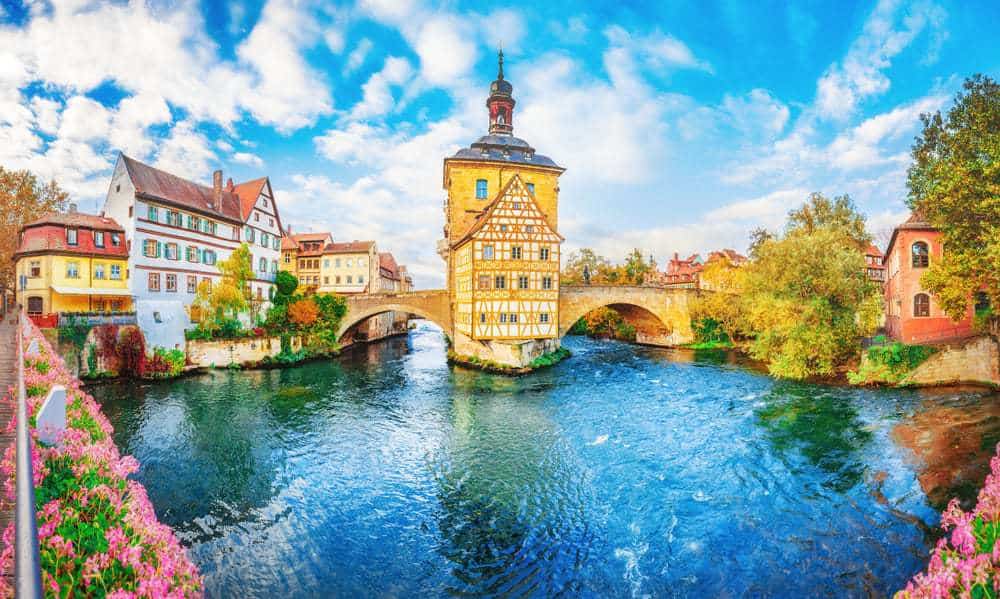
10 Picturesque Stops On The Romantic Road Germany
Würzburg
The most northern stop on the Romantic Road Germany, Würzburg, is known for its famous wines and vineyards as well as it’s architecture. Marienberg Fortress can be seen on the left bank of the Main as you approach the town on the water. It is one of the cutest small towns in Germany!
Its existence began as defensive walls that were built around an 8th-century church in the 1200s and over time it evolved into a Renaissance and then a Baroque palace. The fortress was the seat of the Prince-Bishops for almost five centuries.
Before Prince-Bishop Johann Phillipp von Schönborn commissioned the Würzburg Residence in the 18th century as their new seat he created a formal garden, Fürstengarten, with views of the Main and new palace on the old ramparts of the fortress. Today both can be visited through tours.
The only UNESCO World Heritage Site on the Romantic Road Germany, Würzburg Residence, boasts the largest fresco in the world above the grand staircase. Painted by Giovanni Battista Tiepolo the fresco symbolizes the four continents Europe, America, Asia, and Africa. Despite the palace being hit during World War Two, it is still in good condition. The palace’s chapel is considered one of the high points of sacral Baroque architecture with 6 white marble statues and marble, stucco, and gilt work in abundance.
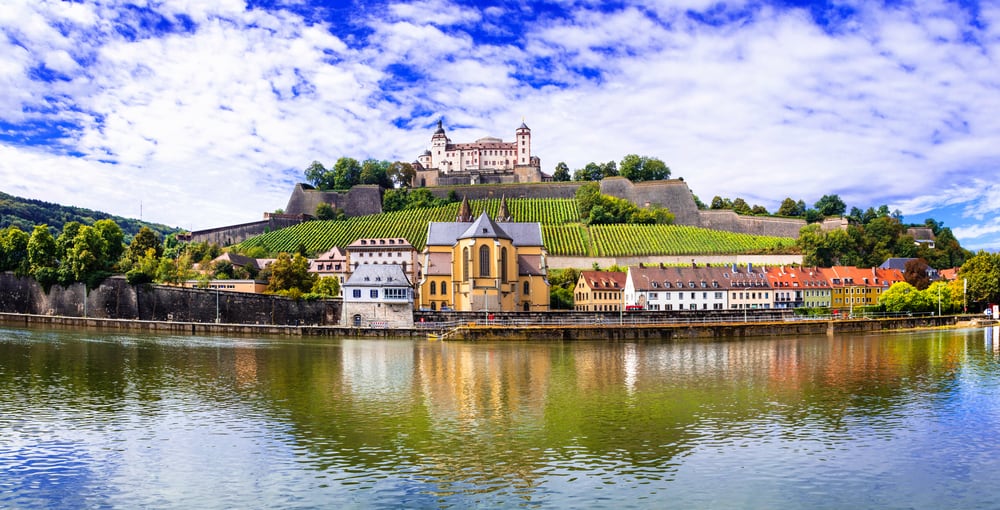
There is so much that can be said about the architecture alone in this stop on the Romantic Road Germany alone it’s hard to move on. To name just a few other beautiful pieces of architecture Marienkapelle is a beautiful chapel in the late Gothic style in bold red and white with intricate spires and statues, the Cathedral is the fourth largest Romanesque church in Germany (and burial place of the Prince-Bishops), and Kollegiatstift Neumünster started as a Romanesque basilica but had extensive Baroque remodeling. That’s not even the end of the list so if you want to see some amazing architecture Würzburg is a must stop on the Romantic Road Germany. All these buildings are full of history and art but there are also several local museums you can visit for more art and archaeology as well.
With so much architecture and art to visit you might be lead to think that is most of what Würzburg has to offer but there’s more! One of Germany’s most important wine producing areas you will find many vineyards in the area, although only one is in the city itself. Within the city you can do walk the old city Wine Trail or if you have time visit one of the wineries outside of the city. Sample the local wine at the bars and restaurants in the city and grab a gourmet dinner. At Restaurant Alte Mainmühle you can grab a local wine from a little kiosk window and enjoy it on the bridge taking in views of the Main, the fortress, and the city. Sausage and bratwurst also originated from this part of Germany so grab some of the best in the world while visiting this stop on the Romantic Road Germany.
Where To Stay In Würzburg:
Maritim Hotel Würzburg. Check Prices: Booking.com
Hotel Würzburg Hoff. Check Prices: Booking.com
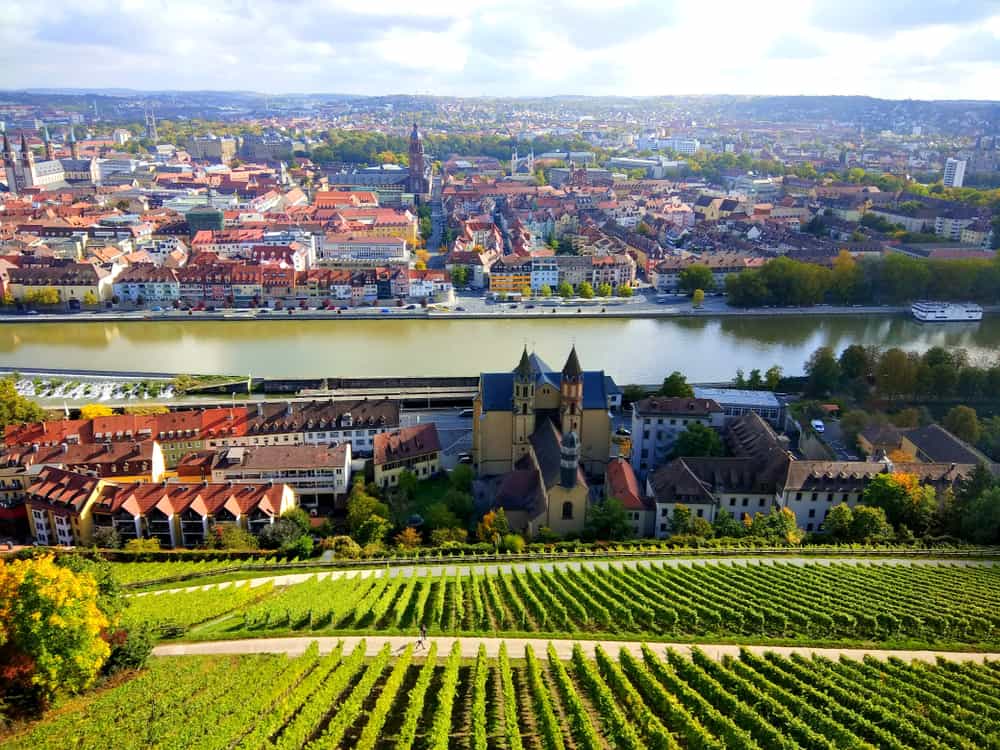
Tauberbischofsheim
Continuing on the Romantic Road Germany, 38km or 23.6 miles, Tauberbischofsheim is a smaller town at the west end of the Tauber Valley along the Tauber River. The Price-Bishops of Mainz left their touch here as well in the form of another 13th-century castle, Schloss Tauberbischofsheim. It replaced in the 16th-century by another castle, Kurmainzische, the seat of the Archbishop. The only structure remaining from the 13th-century castle is the keep tower, Türmersturm. If you visit today, the castle now hosts the Tauberfränkische landscape museum and the Christmas Market.
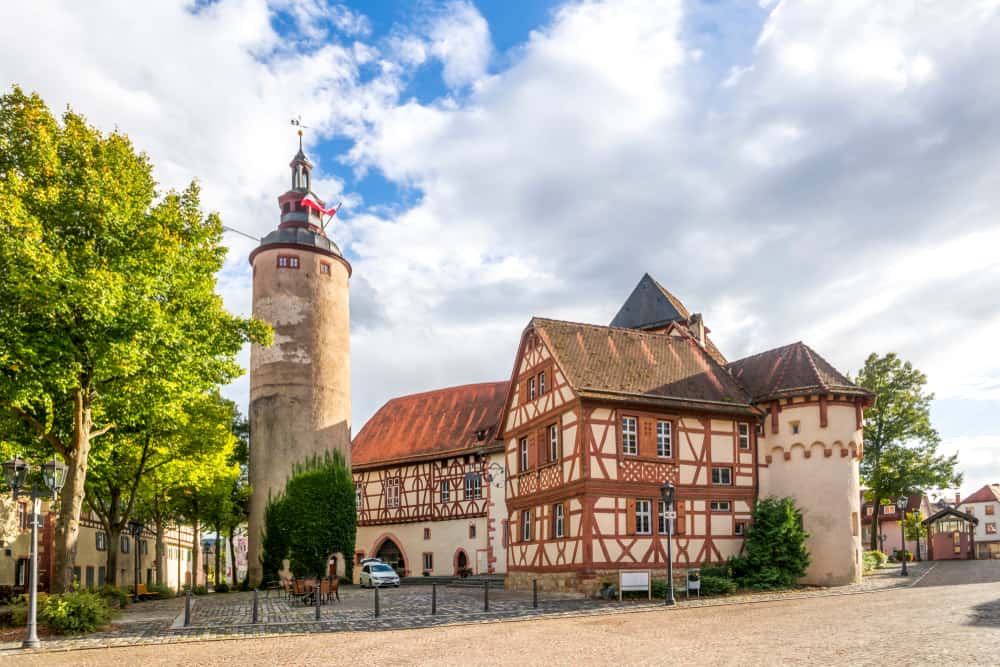
Historical buildings in the form of castles and churches are a plenty on the Romantic Road Germany. In Tauberbischofsheim there is also the gothic revival town hall which is surrounded by the marketplace and half-timbered houses. Several churches can be visited which were built from the 12th-century to 20th-century including St Martin which was rebuilt in 1914 in the neo-gothic style after the previous church burnt down but it does include art from many past churches.
If the history and beautiful half-timbered houses don’t pique your interest Tauberbischofsheim also has an Olympic training center for fencing (and also gymnastics and badminton), a city beach and outdoor pool, as well as numerous walking and cycling paths. The Fencing-Club is the most successful in the world based on medal successes. There are many bike roads that allow no cars, and popular bicycle tours like Charming Tauber Valley along the river. The cycles routes can be as short as one mile or as long as 20 miles.
For food and drink while in Tauberbischofsheim on the Romantic Road Germany, there is the local brewery, Distelhäuser Brewery, as well as local wines and ciders to choose from while dining. This quaint little town on the Romantic Road Germany has more to offer than it might seem at first glance.
Where To Stay In Tauberbischofsheim:
Hotel St. Michael. Check Prices: Booking.com
Badischer Hof. Check Prices: Booking.com
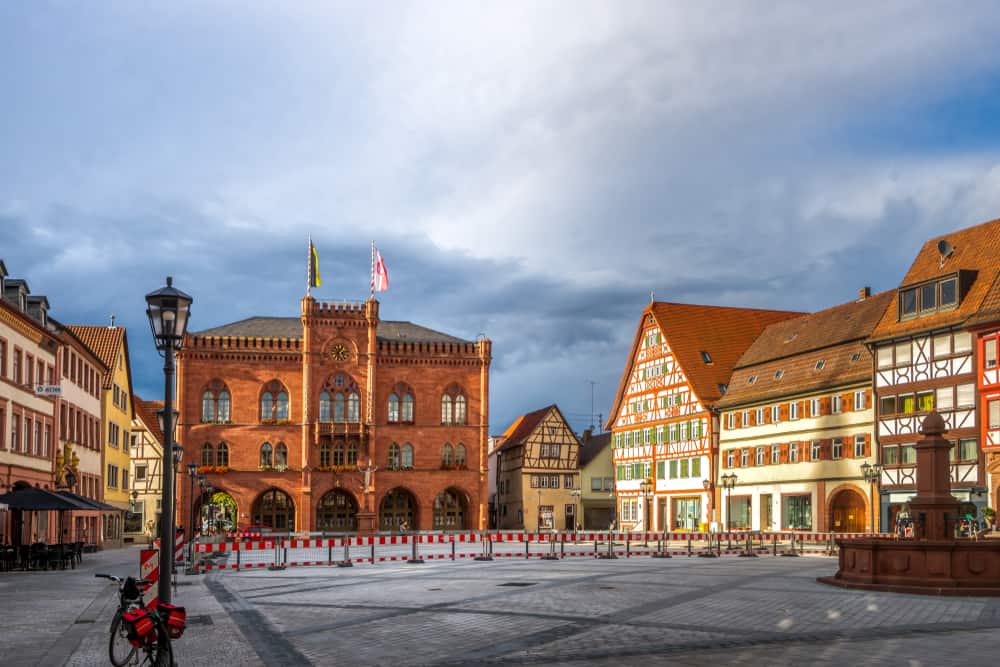
Bad Mergentheim
Returning to the Romantic Road Germany, 21km or 13 miles, Bad Mergentheim is a larger town in the Tauber Valley on the Tauber River famous as a spa town. With over 2,000 trees and a million flowers, the spa park is considered one of the best spa towns in Germany. Some of the main attractions include a Japanese garden, sound garden, sweet rose garden, numerous fountains choreographed with light to music, a concert hall, lavender field, and more. A spa with five pools, saunas, slides, steam baths, and more can be found across the street. Not too far away, you can visit the Castle of Mergentheim Park an English-style park with a lake, bridges, and two pavilions.
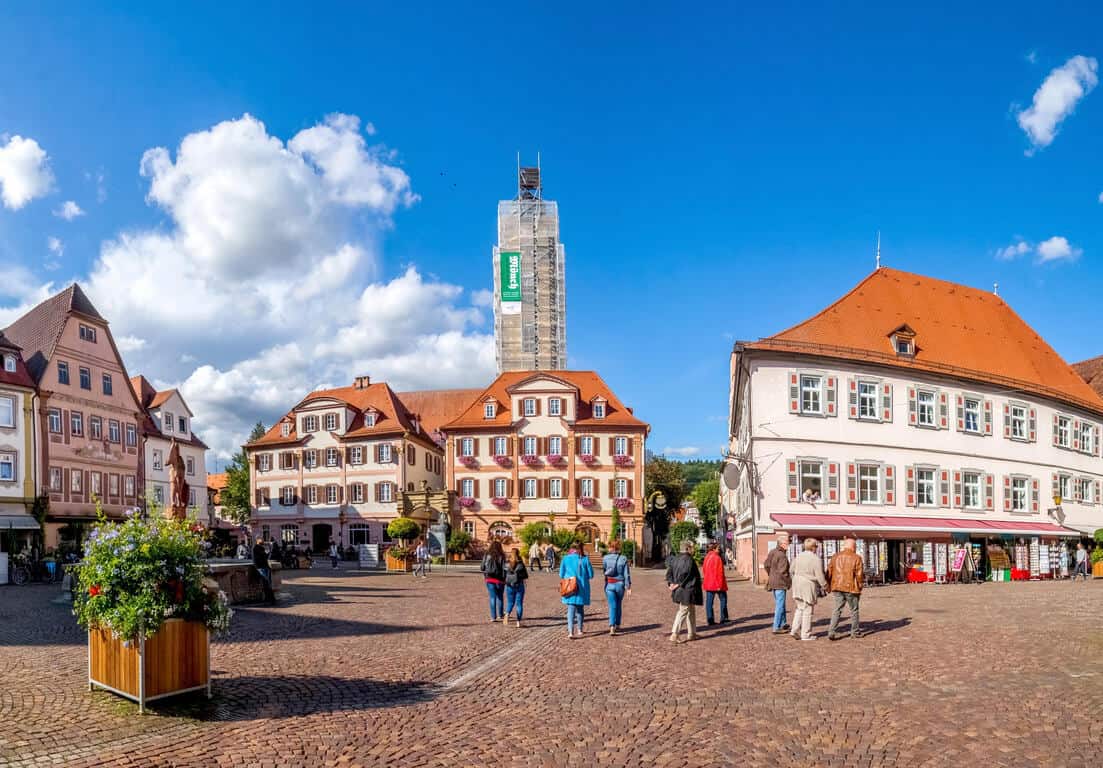
Historically, before Bad Mergentheim became a spa town on the Romantic Road Germany, it was the headquarters of the Teutonic Order who lived in the Castle of Mergentheim. Today the Castle houses the Museum of the Teutonic Order. The museum is full of art, objects, and texts related to the Teutonic order and more in the Renaissance, Rococo, and Classicism styles. More art can be found in the local churches, one within the castle and two in town. Münster St Johannes was built in the 13th century and houses original paintings from the 13th and 16th centuries. Stuppacher Madonna, a painting of Mary with Child, painted by Matthias Grünewald, can be viewed in a small chapel in Bad Mergentheim’s suburb Stuppach.
The unique wildlife park in Bad Mergentheim is a draw for people of all ages with 70 species that are kept in natural material enclosures that approximate their natural habitat as closely as possible and the largest wolf pack in Europe. To get a close-up experience with the animals join the animal keepers on a tour at feeding time. For the adventurous, there are also cycling and hiking trail, canoeing, and pools to be taken advantage of and segway tours too! With so many possible things to do this is a must stop on the Romantic Road Germany.
Where To Stay In Bad Mergentheim:
Hotel-Gastehaus Alte Munze. Check Prices: Booking.com
Stadthotel Miya. Check Prices: Booking.com
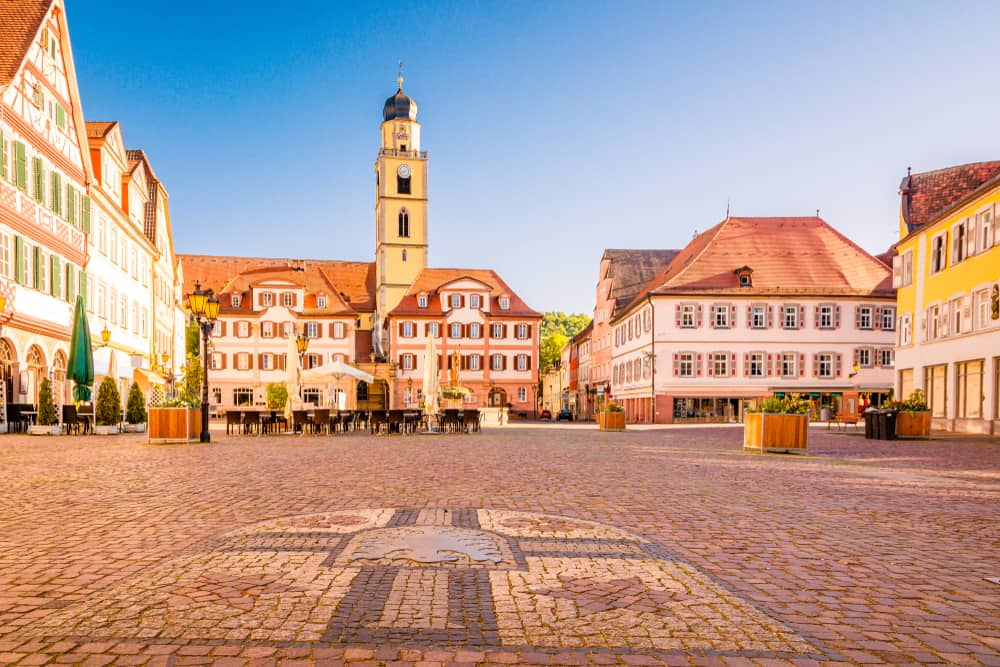
Rothenburg ob der Tauber
Heading further South on the Romantic Road Germany, 44km or 27 miles, is Rothenburg ob der Tauber the best preserved medieval town in Germany. It is also located in the Tauber Valley on the Tauber River as the previous towns. In the Middle Ages Rothenburg ob der Tauber was German’s second largest city today it has become a huge tourist draw with large crowds but that’s for good reason! Despite the crowds, this is a can’t miss stop on your journey and one of the best places to get some shopping done while you visit. More people day trip to the area so if you’d like to avoid the crowds a bit spend the night!
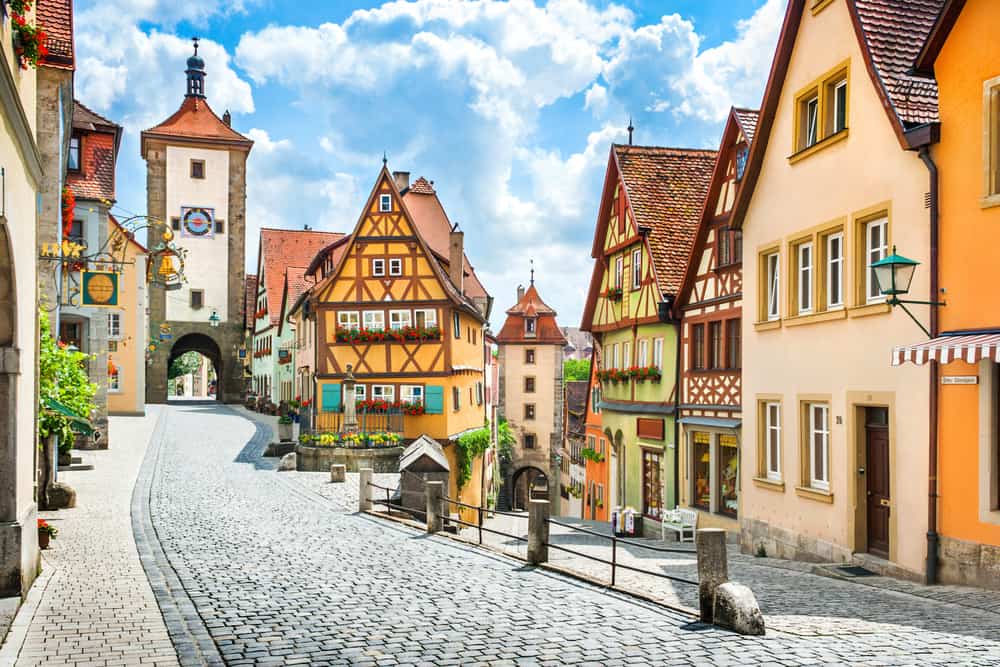
The most iconic parts of preserved medieval towns are the city walls, towers, and gates around the old town as well as the old town itself. Visit Town Hall Tower for views, definitely recommend doing this near sunset, of the town and surrounding countryside and then walk the city wall to see more. Afterward, if you head into old town, The Plönlein square is known for its cobblestone streets and cute half-timbered houses. For more history visit St Jakob’s Church and it’s 500-year-old altarpiece by Tilman Riemenschneider (the Michaelangelo of German woodcarvers) or check out the Medieval Crime and Punishment Museum which is in English and has tons to see. One of the quirkiest but happiest themes for a museum on the Romantic Road Germany is the German Christmas Museum, located in a lovely Christmas shop in Rothenburg, it walks you through the history of decorations.
To learn about the city while you visit this stop on the Romantic Road Germany grab a walking tour, like the Night Watchman tour, beginning in the marketplace and let your guide tell you more about the history. Then head over to the Old Castle Gardens and follow the nearby trail to a 15th-century summer home for the mayor and continue meandering along the river to the village Detwang. To see more of the countryside grab a bicycle rental and check out old mills, apple trees, chickens, and more.
Where To Stay In Rothenburg ob der Tauber:
Romantik Hotel Markusturm. Check Prices: Booking.com
Hotel Eisenhut. Check Prices: Booking.com
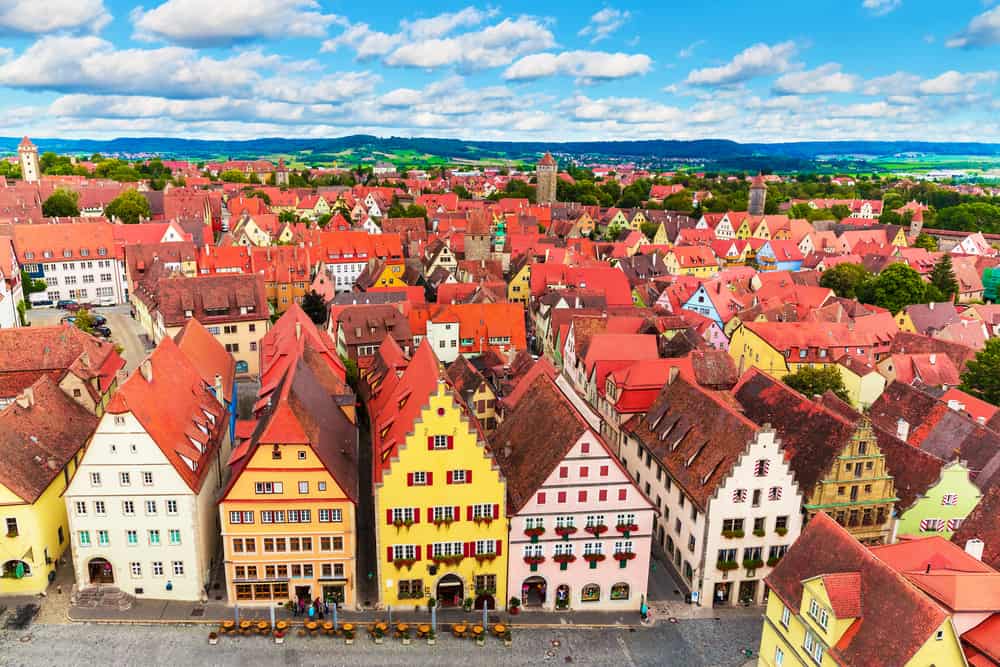
Dinkelsbühl
Continuing on the Romantic Road Germany, 45km or 28 miles, Dinkelsbühl is widely considered the most beautiful city in Germany. Spend some time getting lost in old town with its colorful half-timbered houses, Medieval city walls, towers, gatehouses, and more all of which grew organically with completely unplanned streets. While you’re there, stop into St. Georgs Kirche (Church) with it’s imposing tower and walk up to the top to enjoy views over the city, then visit the abundance of art and alters from the 15th and 16th centuries. Then head over to Weinmarkt too see the gabled houses from the 17th-century and check out the unique Deutsches Haus the 15th-century home of the Counts of Dreschsel-Deufstetten with a Renaissance facade of ornate timber framing with carved images of Mary and Child, the Roman wine god Bacchus, and more.
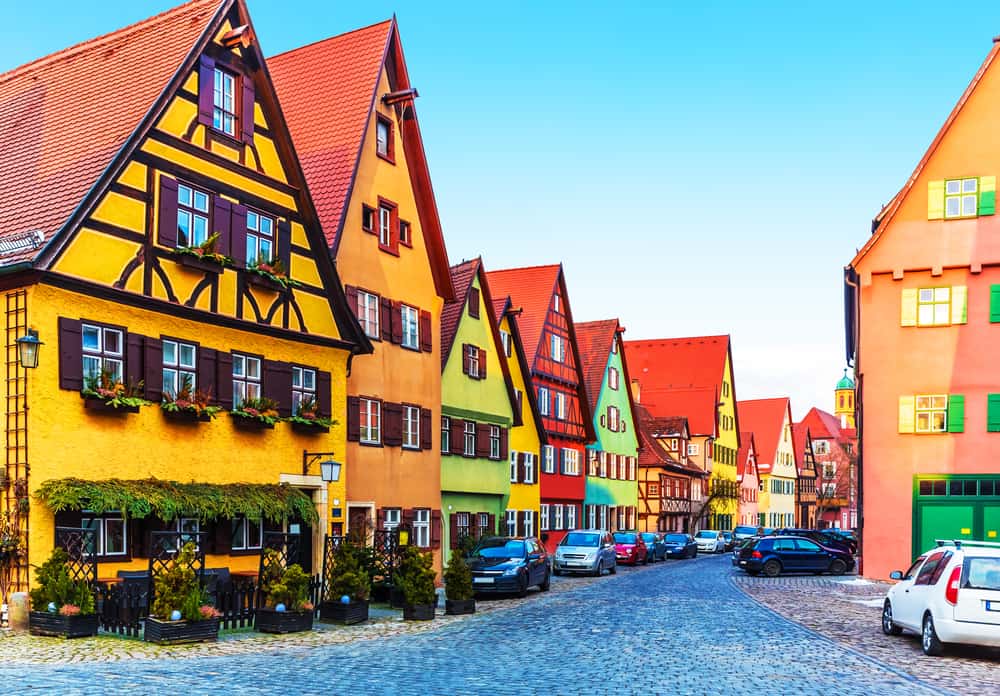
Around this city, on the Romantic Road Germany, you’ll find several towers and gates in the city walls once used to control who entered and protect the city. In the north, the tower, Rothenberger Tor, controlled what was in Medieval times a busy highway and housed a prison and torture chambers on the second floor. Segringer Tor is a more unique tower because it was rebuilt in 1648 after sustaining damage in the Baroque style, unlike the others. In the east Nördlinger Tor und Stadtmühle was built in 1400 and altered in the 16th-century to include a Renaissance gable, it resembles a fortress more than the watermill it is. Today you can visit the 3D museum inside which is fun for all ages and view stereograms, 3D photographs, anaglyphs, and optical illusions.
Haus der Geschichte, the old town hall built in the 14th-century and updated through the 16th-century, houses the cities history museum. The walks through the history of the city using portraits, armor, weapons, trade equipment, tools, and more. Dinkelsbühl is also home to Deutschordensschloss a Baroque palace of the Teutonic Order with a Rococo chapel, Spitalanlage a medieval almshouse built in 1280, and Stadtpark which was updated in 1988 when it hosted the Bavarian State Garden Show. On Wednesday and Saturday mornings visit Wochenmarkt for the stalls set up selling flowers, fruit, veggies, cheese, pastries, and meats.
Where To Stay In Dinkelsbühl:
Hezelhof Hotel. Check Prices: Booking.com
Meiser’s Hotel am Weinmarkt. Check Prices: Booking.com
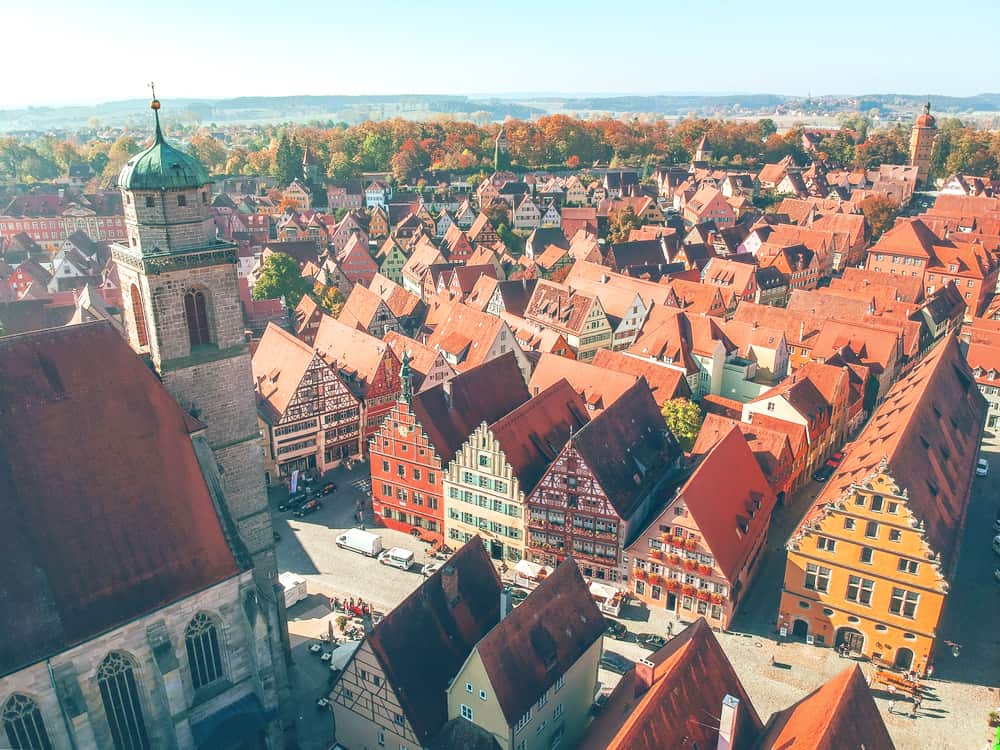
Harburg Castle
Journeying further south on the Romantic Road Germany, 49km or 30 miles, Harburg (Harburg an der Wörnitz or Harburg (Schwaben), not to be confused with a suburb of Hamburg with the same name) is on the Wörnitz river and is home to Harburg Castle. Crossing the river you can see an example of an Old Stone Bridge that has been restored. As with many of the towns on the Romantic Road Germany here you will see half-timbered houses, a marketplace, and several more impressive homes and churches and can find nearby hiking and cycling trails. Schwarzkopf House and St. Barbara Church are both worth a visit and the Church can be viewed on the way up to the Castle.
Read more: 10 Stunningly Beautiful Castles In Germany You Must See
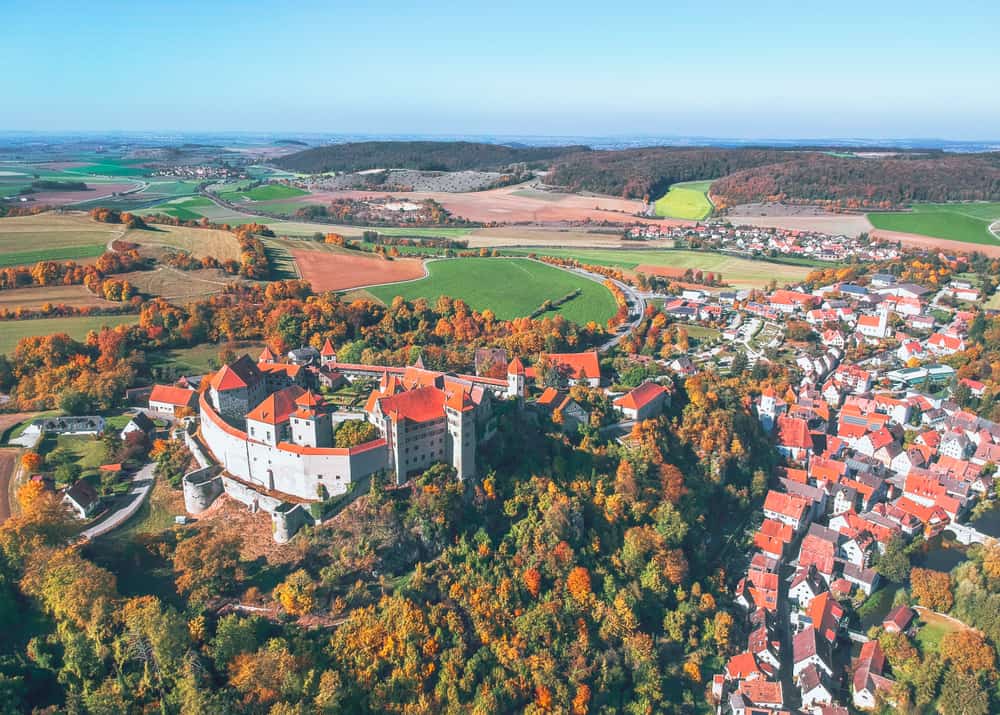
The town itself is a small medieval town with the Harburg Castle being the main draw for this stop on the Romantic Road Germany. Harburg Castle is first mentioned in writing in 1150 and believed to have been built in part as early as the 10th or 11th century by Hohenstaufen emperors of Germany. With such a long history behind it, the castle is considered one of the oldest castle fortifications in Germany with the present fortifications being from the 18th-century.
To get a different perspective on the castle Bock Trail, which begins in the lower castle parking lot, circles around the land near the castle and end right by the entrance of the castle. The hike is 9km or 5.6 mi long, passes a former cemetery, the viewing platform of Pluto stations of the Ries crater planetary path, through a forest, garden, and grass paths. When the trail end in front of Harburg Castle can be visited as well or you can skip the trail completely. Tours are available except on Mondays and offseason. The castle has a house, chapel, sentry walk, prison tower, dungeon, six towers, a courtyard, ballroom, and various other rooms and structures quite a few of which are open to the public. It also has a hotel restaurant you can grab a bite to eat.
Where To Stay In Harburg:
Schlosshotel Harburg. Check Prices: Booking.com
Hotel-Restaurant Straussen. Check Prices: Booking.com
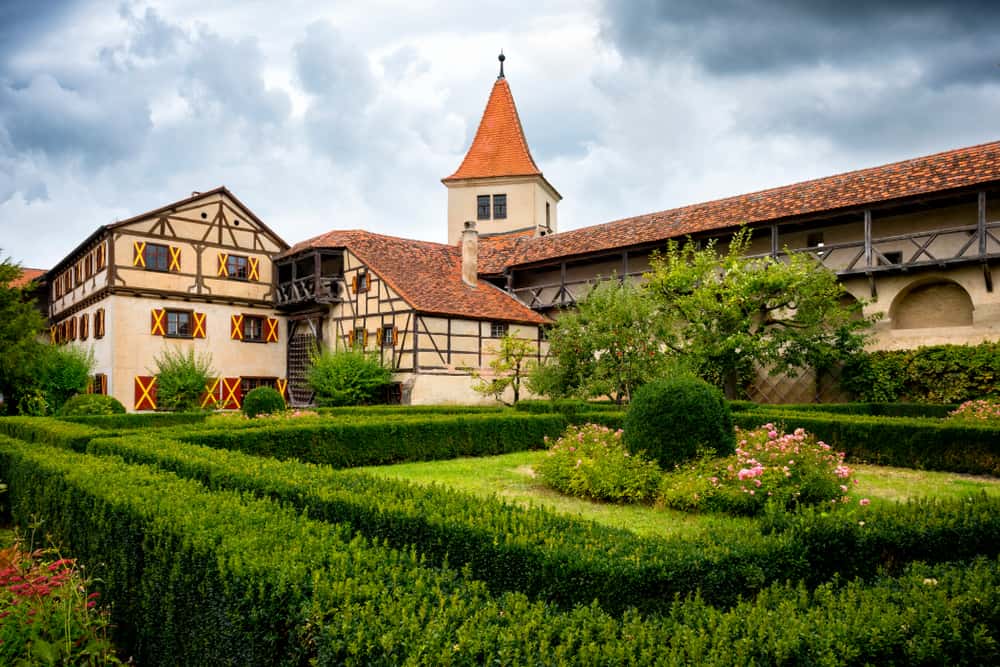
Augsburg
Heading back to the Romantic Road Germany, 56km or 34.8 miles, Augsburg is the third oldest German city and full of baroque townhouses, historic buildings and art, and traditional restaurants with medieval candlelight dinners. Two merchant families left behind huge legacies in Augsburg that extend far beyond the city throughout Europe and the World, the Fugger and Welser families. Their work is commemorated in the Fugger-und-Welser-Erlebnismuseum which instead of displaying artifacts builds an experience of the period of their prominence through movies, sound, projections, and other interactive displays. It also aims to explain their impact through the reaches of time and on today’s economy.
The Fuggers left behind much more to be seen in Augsburg as well. Their home, Fuggerhäuser, was a complex of interconnected houses and courtyards, the first Renaissance home north of the Alps, the courtyards are open to the public and breathtaking. Jakob Fugger also began the worlds oldest social housing project, Fuggerei, in 1516 that has a total of 52 houses that to this day have residents abiding by strict rules including that they must be of the catholic faith and pray for the souls of the Fuggers.
History has breath within the many cities on the Romantic Road Germany but none as much as Augsburg. In the old town part of Augsburg, Maximilianstraße, is one of the cities most historic streets. It has been walked since the days of the Romans and was a major trade route. Meander down this street to catch a glimpse of the history and stop by the Fuggerhäuser while in the area.
Visit each of the three Mannerist fountains thematically linked to Augsburg’s ancient origins and made in commemorations of the 1,600th anniversary of the city. The Augustus Fountain was finished first in 1594, the Mercury Fountain in 1599, and finally the Hercules Fountain in 1600. City Hall was also updated in the 1610s during the Renaissance to reflect the wealth and power of the city, the Golden Hall with its gilded coffered ceiling, doorways, and mural frames is the most stunning room.
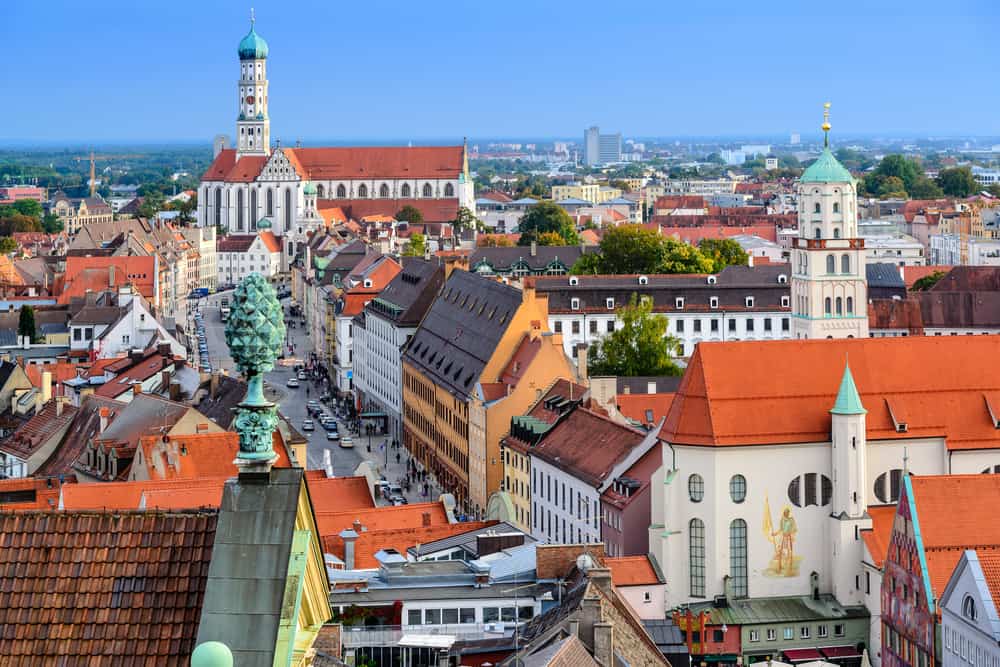
The churches in Augsburg have their own unique place in the history of this Romantic Road Germany stop. The Augsburg Cathedral has parts that date back as far as the 1000s although much of the current building is in the Late Gothic style and from the 14th century. The ornate exterior is full of sculptures telling the life of Mary, stories of the apostles, and the life of Jesus while inside is home to some fantastic stained glass and paintings.
St Ulrich’s and St Afra’s Church was once an Imperial Abbey, making it an independent state of sorts, and is easy to spot by the Baroque onion dome at the top of its tower which contrasts its current facade in the Late Gothic style. St. Anne’s Church was originally part of a 14th-century monastery, the Fuggers burial chapel started here in 1509, it was visited by Martin Luther in 1518, and became Lutheran in 1545. In the 18th-century it was updated in the Rococo style with stuccowork and bold frescos.
One of the more unique attractions on this Romantic Road Germany stop is the Augsburger Puppenkiste, Augsburg’s puppet theater, which dates back to the 17th-century and is located in the Holy Ghost Hospital. In the 20th-century the puppet adaptions of fairytales and children’s books were broadcast on television to success. There is a museum on location housing the theater’s most famous marionettes.
To experience a wide variety of species Augsburg has a Zoo and the Botanischer Garten with 300 species and 3,100 species respectively. The Zoo is home to 1,600 creatures total including fur seals, rhinos, giraffes, lions, tigers, mountain goats, ibexes, and more. The Garden has 1,200 tropical and subtropical species grown in greenhouses, a Japanese garden, rockery, a rose garden with 280 variations, apothecary garden, farmer’s garden, sunken garden, and 450 species of shrubs and perennials. There is so much to see and do in Augsburg this stop is a must on the Romantic Road Germany.
Where To Stay In Augsburg:
Hotel am alten Park. Check Prices: Booking.com
Quality Hotel Augsburg. Check Prices: Booking.com
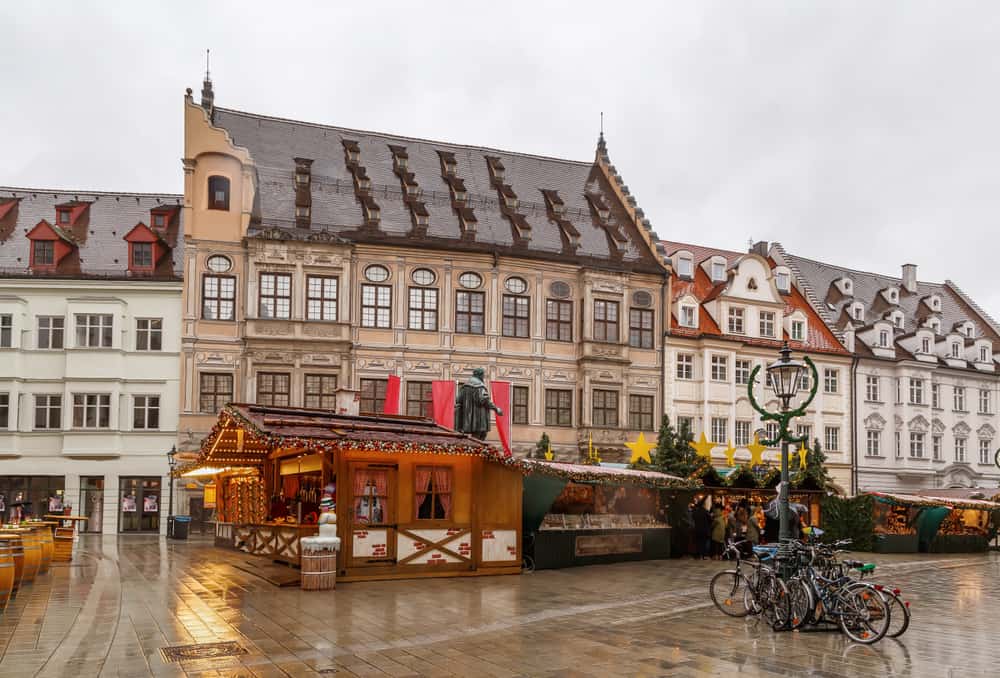
Landsberg am Lech
Approaching the end of the journey on the Romantic Road Germany, 39km or 24 miles further south is Landsberg am Lech. Yes, this is the city in Germany famous for its prison where Adolf Hitler was detained and wrote Mein Kampf but there is so much more to be found here than this one piece of history. It has well-preserved medieval town walls with original towers, pastel-colored buildings, and was along a Roman trade route. Feeling the summer heat? Landsberg is also home to Inselbad am Lech a recreational facility with a wave pool, diving platform, sports pool, slide, and more.
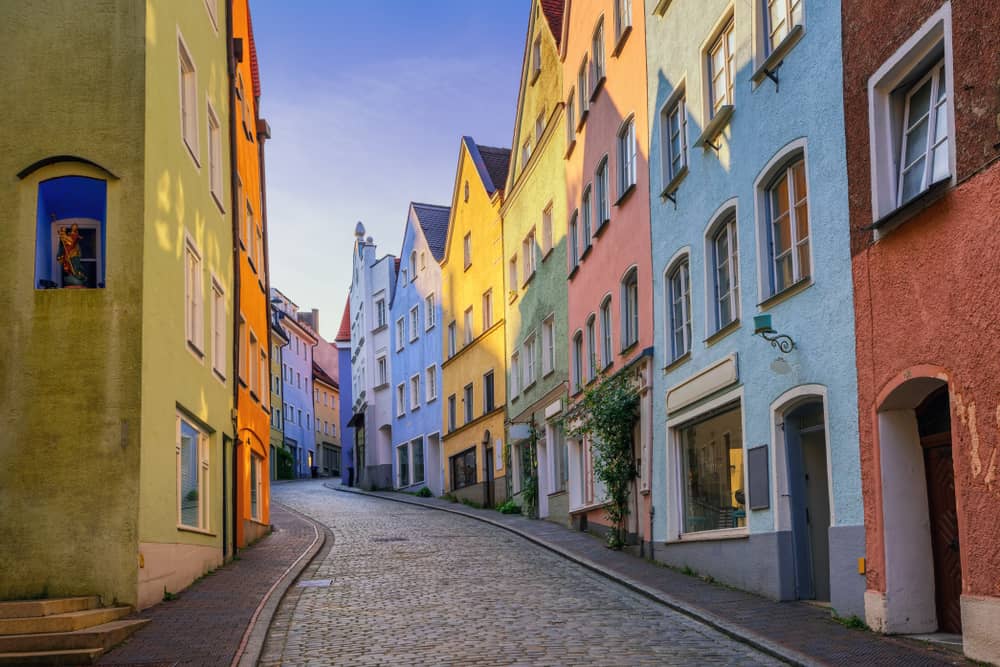
Although not a part of today traditional entrance from the Romantic Road Germany to the town one of the original towers from 1425 along the medieval town walls, the turreted Bayertor gateway, was one way to enter the city. It has ornate details done in colorful painting and the coat of arms of the Bavarian dukes of past times on its facade. You can step inside to visit the clock and get a bird’s eye view. This quaint city is split almost in half by the old town which is dominated by the imposing 15th-century Stadtpfarrkirche Mariä Himmelfahrt basilica. What’s really amazing about this church is the interiors, its Madonna and Child sculpture, and Gothic stained glass. The entrance draws you into the heart of the church where the exquisitely carved and painted altar towers above and all the fine details call for closer inspection.
Just outside of Landsberg am Lech on the Romantic Road Germany the European Holocaust Memorial can be found. The largest concentration camp complex in Germany was built here towards the end of World War II and the memorial was created from the remains of bunkers in the fields and woods. It is located off a country road with no official opening times but a guided tour can be arranged. Back within the city, the Herkomer Museum housed in a tower built as an atelier by the artist Hubert von Herkomer and includes a collection of his work. During different times of year, Landsberg am Lech hosts many different markets including farmer’s markets, pottery markets, Christmas markets, and more.
Where To Stay In Landsberg am Lech:
Zweite Heimat Privatpension. Check Prices: Booking.com
Lech City Life. Check Prices: Booking.com
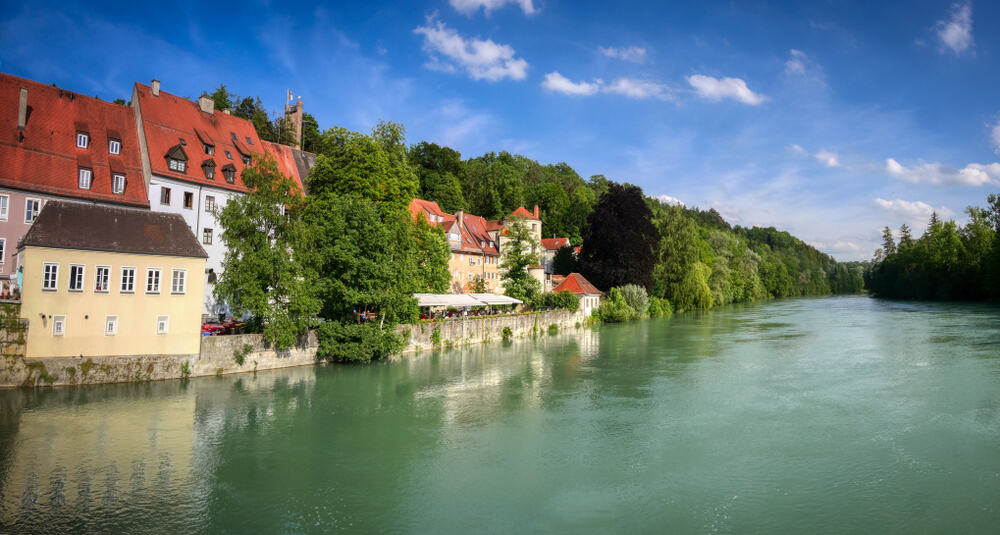
Pfaffenwinkel
Getting towards the end of the journey on the Romantic Road Germany, 46km or 28.5 miles south, Pfaffenwinkel is famous for the 159 churches and numerous monasteries in the area. The landscape surrounding these many historic places of worship is also breathtaking with rolling hills leading to the Alps in the distance and along the Ammer River. Even the name reflects the copious number of churches, Pfaffenwinkel in the local dialect translates to “Priests’ Corner.”
The most famous local church is the Pilgrimage Church of Wies (Wieskirche) a UNESCO World Heritage Site with the Steingaden Abbey next door. This church has a unique history as it was built after a woman in 1738 saw tears in the eyes of the statue Scourged Saviour in the Meadow in Wies by Steingaden and people began pilgrimaging to the site. The church is in the Rococo style and receives one million guests a year! Even if you aren’t into the religious aspect the history, architecture, and art make this a can’t miss stop on the Romantic Road Germany.
With 158 more churches in Pfaffenwinkel on the Romantic Road Germany, the list could feel unending so here are just a few. The Abbey of Rottenbuch retained its original medieval layout despite being altered and has an unusual exposed tower and frescos painted by Matthaus Gunther. The church of Mariä Himmelfahrt (The Ascension of the Virgin Mary) is a beautiful church in the baroque style with a stucco pulpit with a gothic Virgin Mary.
The baroque Monastery Ettal began in 1330 and was a pilgrimage destination with their famous Ettal Madonna, today it includes farms, inns, a high school, art publisher, distillery, and brewery museum. Rottenbuch Monastery, today a resort, includes a 10th-century Romanesque basilica, which has survived several files, the collapse of its tower, and war to later be expanded in the Baroque style.
The gorgeous scenery and the unique and numerous churches with their history and art may be what this area is famous for but it is not all there is to do on this Romantic Road Germany stop. Several local museums include the Auerberg museum, Stadtmuseum Schongau, and the Penzberg Museum. The Auerberg Museum looks at settlement in the area from the early imperial period digitally reconstructs the construction and function of strip houses from Roman times and looking at the ramparts, wooden architecture, arms production, and pottery.
The Stadtmuseum Schongau is a municipal museum in an old hospital church, St. Erasmus, a collection of coin on the history of money and with pre and early age era of Schongau county history. The Penzberg Museum houses the world’s largest collection of work by Heinrich Campendonik. Different villages in the area host unique events including a medieval market, the Osterseen lakes can be found in the are, many hiking and cycling trails, golf, a waterpark and other activities.
Where To Stay In Pfaffenwinkel:
Altenauer Dorfwirt. Check Prices: Booking.com
Pension Maria. Check Prices: Booking.com
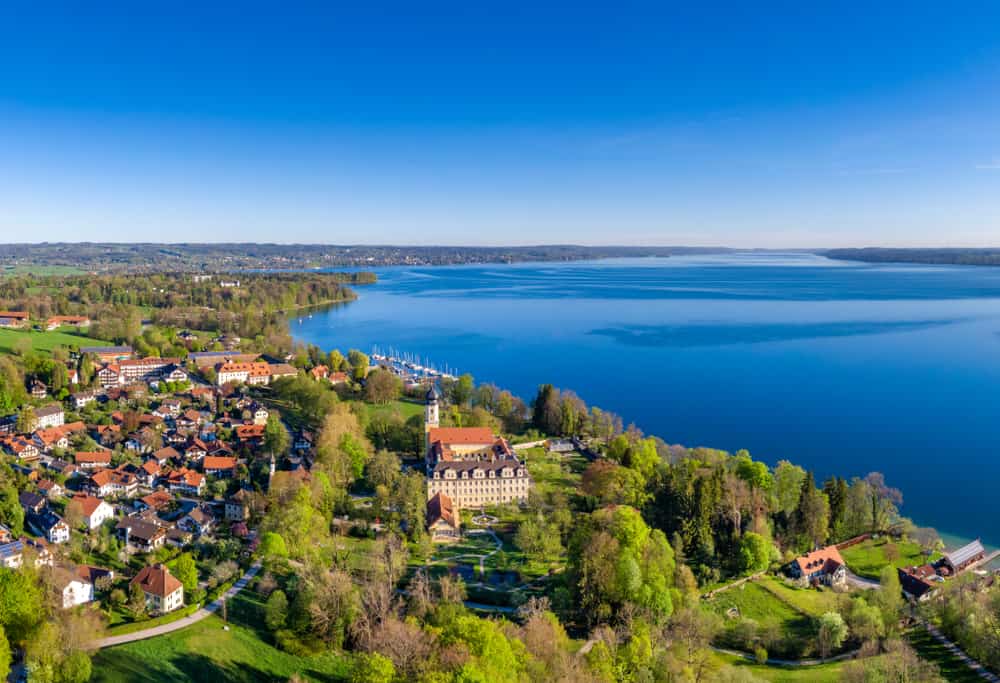
Schwangau
The last stop on the Romantic Road Germany, 29km or 18 miles south, Schwangau is most well known for the Neweschenstein castle “the fairytale castle” commissioned by King Ludwig II in 1868 in the medieval style but with modern amenities, it is still incomplete to this day. A popular destination as one of the can’t miss castles in Europe tickets should be booked in advance to avoid long lines. While Neweschenstein is the more famous the Schwangau area is also home to the Hohenschwangau Castle and the Museum of the Bavarian Kings. The Hohenschwangau Castle was the summer home of King Ludwig II before he commissioned the building of Neweschenstein but it’s history dates back to the 12th-century. The Museum of the Bavarian Kings focusing on the period from 1806-1918 shows the history of the Wittelsbach dynasty and offers an audio tour in ten languages.
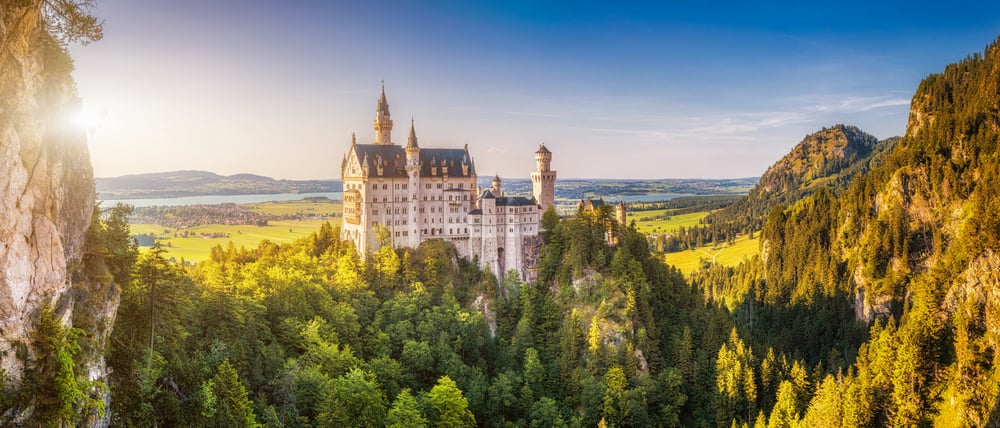
This stop on the Romantic Road Germany is closer to the mountains and has even more hiking, climbing, and cycling options. From Neweschenstein Castle and in the area, in general, there are several trails that can be walked for a different vantage point of the castle before or after your visit. The local mountains and lakes have many other trail options as well as the Tegelberg-cablecar used for skiing in winter or for a ride to the epic view at the top of the mountain. Sailing, fishing, and swimming are popular activities at the local artificial lake, Forggensee, when there is sufficient waterfall. Schwansee if another lake in the area that is a short walk to visit before or after Neweschenstein Castle to swim or picnic.
St Kolman’s Church has a picture-perfect appeal with a backdrop against the mountains that will encourage you to pull over and experience the scenery while on your way to Neuschwanstein, avoid crowds by stopping earlier in the morning. The Royal Crystal-Spa offers relaxing opportunities with views of both castles and the mountain landscape. There are so many activities to choose from everyone can find something of interest on this Romantic Road Germany stop.
Where To Stay In Schwangau:
Helmerhof. Check Prices: Booking.com
Hotel Weinbauer. Check Prices: Booking.com
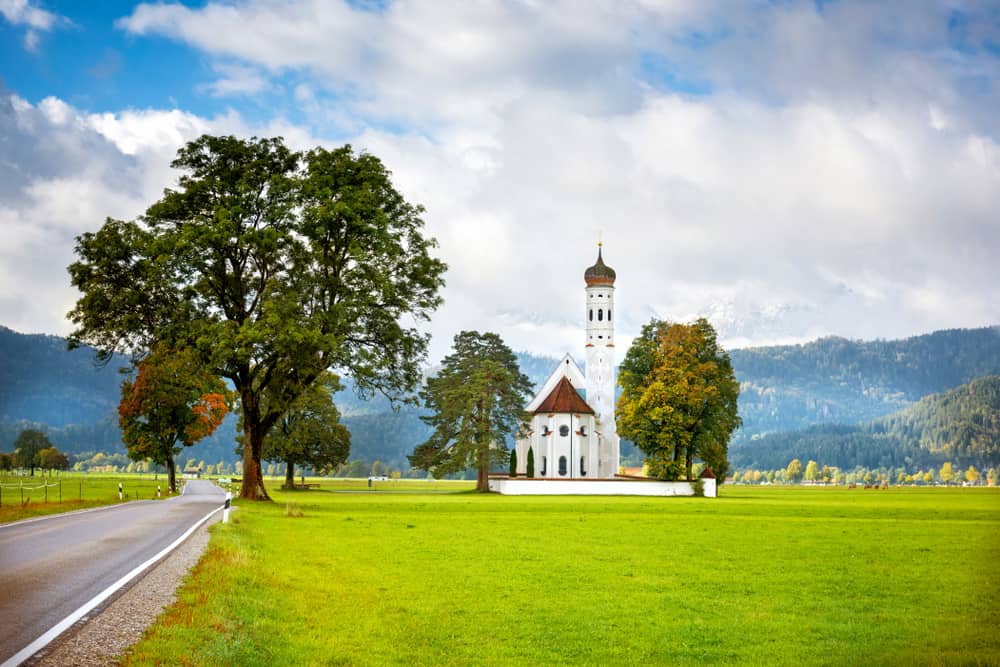
The Romantic Road Germany is steeped in history and rich in luscious landscape with many historic buildings, museums, outdoor activities, spas, food and wine, and so much more to experience. It can be hard to decide where to spend more time depending on the length of your trip because you could do it all in one day (no recommended) or anywhere from three and on. No matter how much time you spend you will be immersed in the old-world charm of the villages, towns, and cities on the Romantic Road Germany.
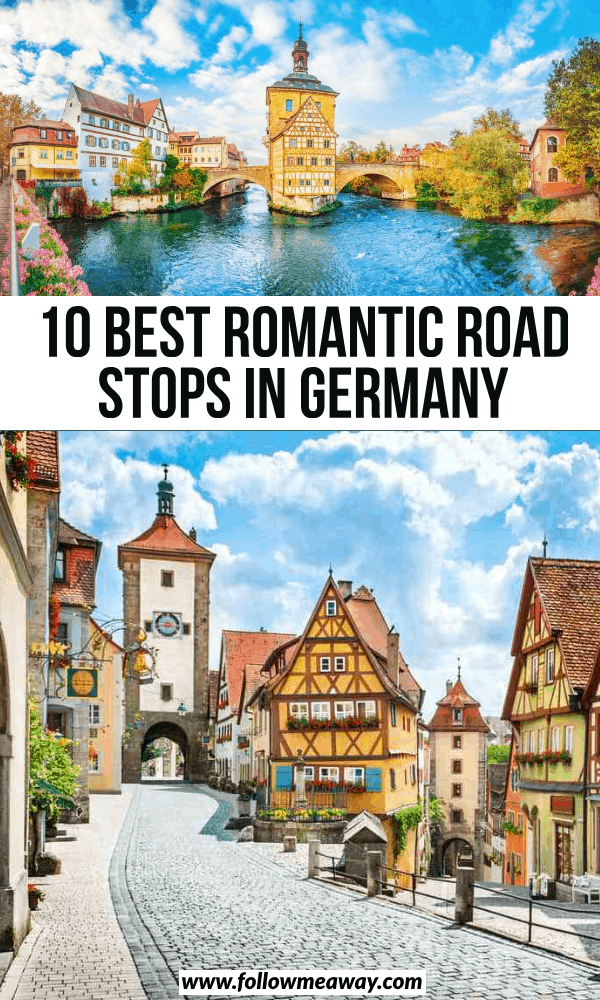
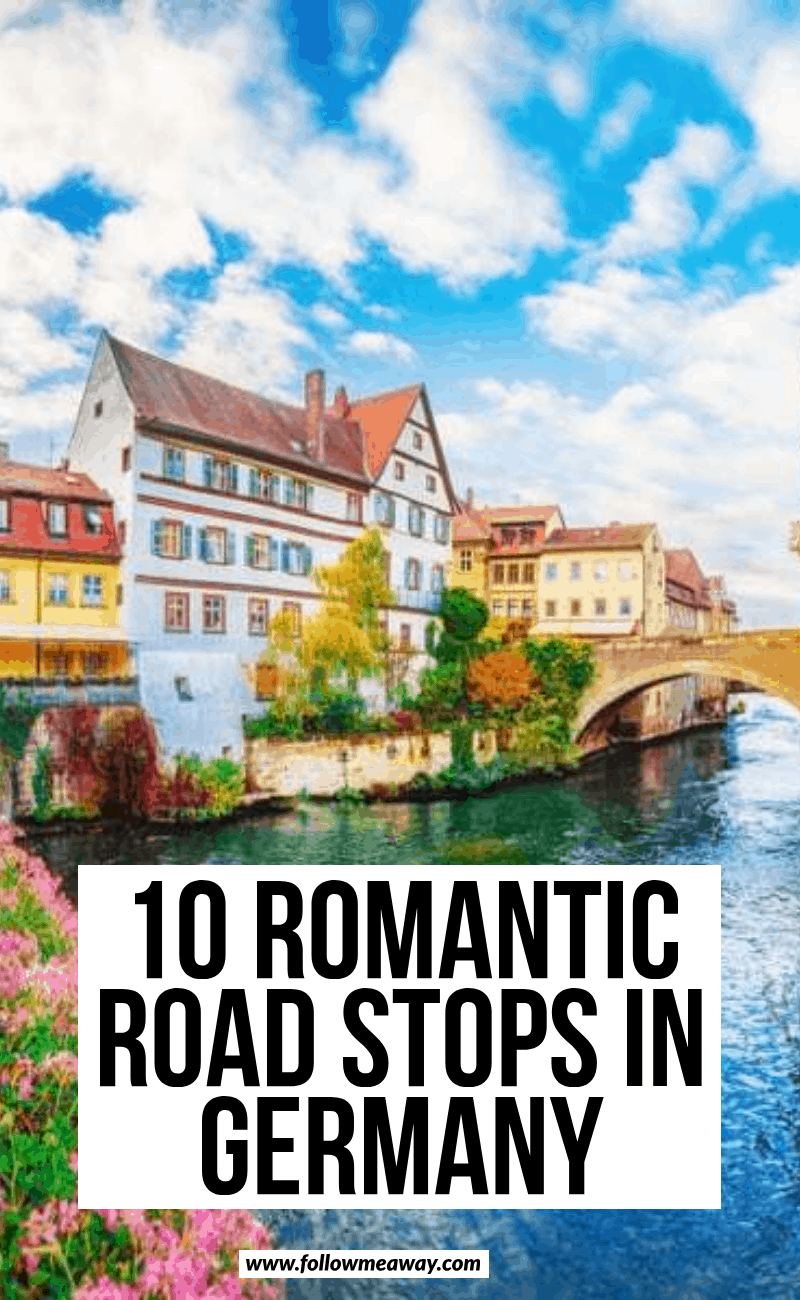
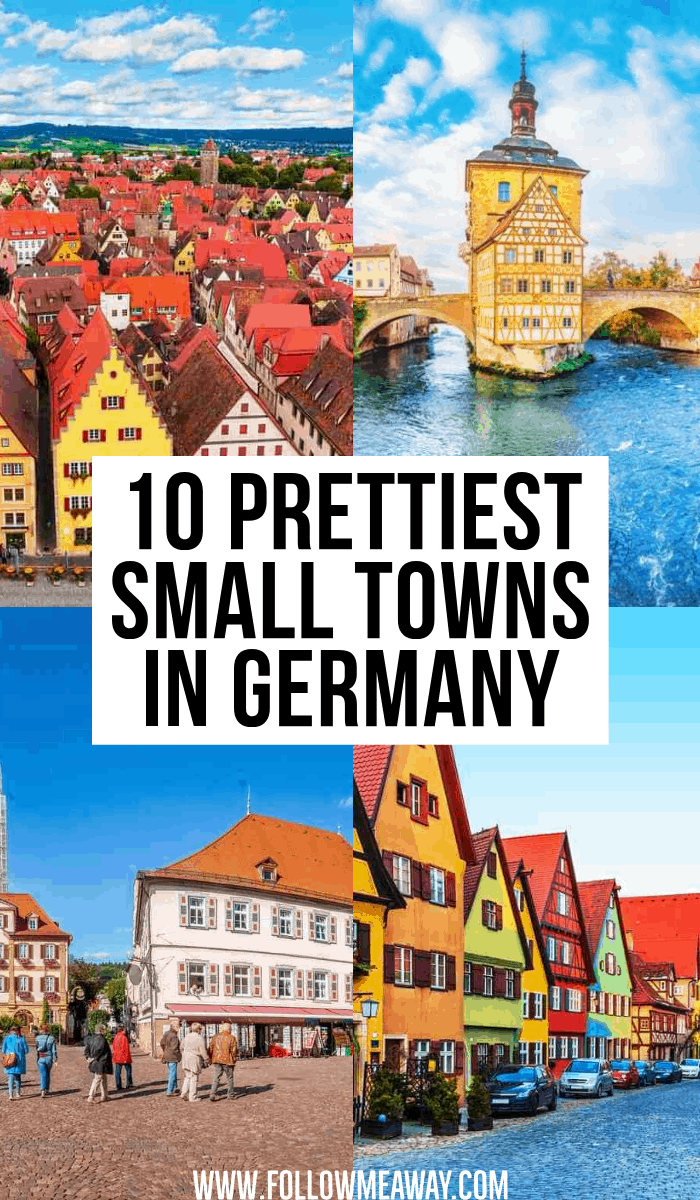
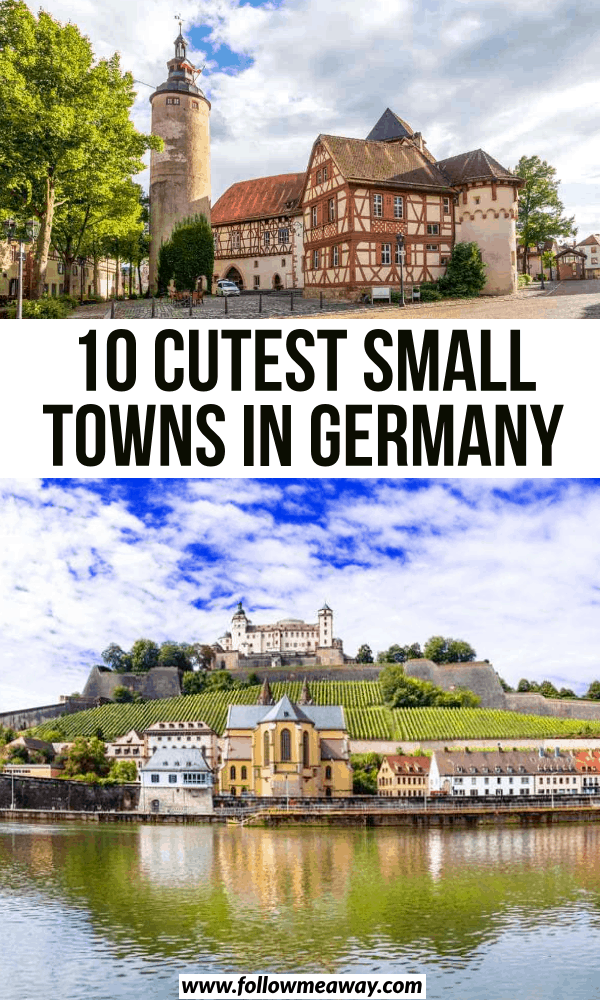
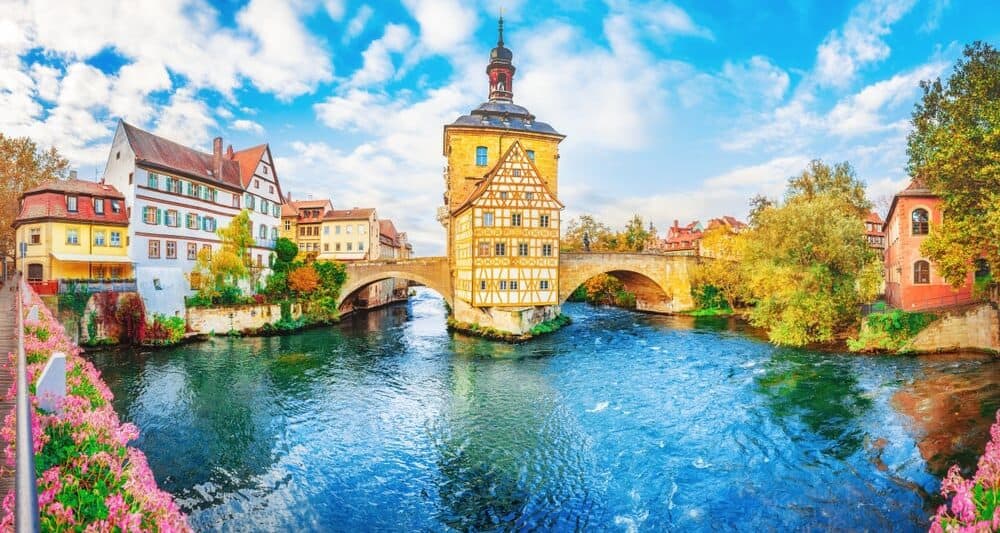
 10 Cutest Cotswolds Villages Out Of A Storybook
10 Cutest Cotswolds Villages Out Of A Storybook